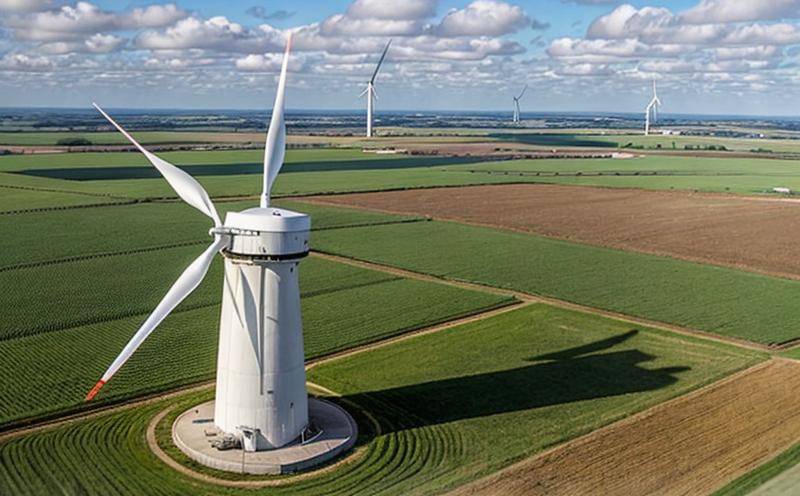ISO 226 Equal-Loudness Perception Testing of Wind Turbine Noise
The ISO 226 standard provides a basis for equal-loudness perception curves that are essential in the assessment and regulation of noise levels. In the context of wind turbines, this test is critical as it helps to ensure compliance with international standards related to acceptable ambient sound levels near residential areas and other sensitive environments.
Wind turbines generate significant amounts of noise during operation. The noise can be caused by aerodynamic forces acting on the turbine blades, mechanical components, or even air turbulence behind the turbine itself. This noise is not uniform across all frequencies and intensities, making it important to use a standardized method for measuring and comparing sound levels.
The ISO 226 standard defines equal-loudness contours, which are curves that represent the perceived loudness of pure tones at different levels and frequencies. These contours provide a way to compare sounds across various frequencies in a manner that is consistent with human perception. By applying these contours to wind turbine noise measurements, we can ensure that the testing accurately reflects how people perceive the sound.
For ISO 226 equal-loudness perception testing of wind turbines, our laboratory follows strict procedures outlined by the standard. This includes using calibrated sound level meters and octave band analyzers to capture the frequency content of the noise generated by the turbine. The data is then processed to determine the equivalent continuous A-weighted sound level (Leq(A)) over a specified time period.
Once the initial measurements are taken, they undergo rigorous quality assurance checks. This involves comparing results against previous tests on similar turbines and ensuring that all instruments are properly calibrated. If necessary, adjustments are made before finalizing the report.
The testing process is designed to be comprehensive yet efficient. It typically takes between 2-3 days from start to finish, depending on factors such as travel time for fieldwork and the complexity of the site being tested. During this period, our team works closely with clients to ensure they understand every step involved in the process.
Understanding these nuances allows us to deliver accurate reports that meet both regulatory requirements and client expectations. Our approach ensures not only compliance but also provides valuable insights into how wind turbines impact their surroundings acoustically.
Scope and Methodology
| Test Parameters | Description |
|---|---|
| Frequency Range | 0.5 Hz to 16 kHz |
| Sound Intensity Levels | -10 dB to +20 dB re: A-weighted sound pressure level (dBA) |
| Time Periods | One-minute intervals over a 24-hour period |
The scope of ISO 226 equal-loudness perception testing includes the measurement and analysis of sound levels produced by wind turbines. The methodology involves setting up equipment at specific locations around the turbine to capture data on sound intensity across various frequencies.
Our team uses state-of-the-art instrumentation, including but not limited to high-quality sound level meters and octave band analyzers. These tools allow us to precisely measure the frequency content of the noise generated by the turbines. The collected data is then analyzed using advanced software that applies equal-loudness curves as defined in ISO 226.
The analysis focuses on determining whether the sound levels fall within acceptable limits according to relevant regulations and guidelines. This includes comparing the measured values against reference levels specified in standards such as IEC 61400-11 for wind energy systems.
Quality and Reliability Assurance
The quality of our ISO 226 equal-loudness perception testing services is ensured through a stringent quality management system. We maintain strict adherence to international standards like ISO/IEC 17025, which govern the operation and performance of testing laboratories.
- Regular calibration of all measurement equipment
- Comprehensive training programs for staff members involved in the testing process
- Continuous monitoring of test procedures to ensure consistency with current best practices
- Detailed documentation and record keeping throughout each project
We also employ a robust quality control program that includes internal audits, external reviews by independent experts, and regular assessments against industry benchmarks. These measures help us maintain high levels of accuracy and reliability in our results.
Our commitment to excellence extends beyond mere compliance with regulations; we strive to provide clients with actionable insights into the acoustic performance of wind turbines. By doing so, we contribute towards safer, more efficient energy production processes while minimizing environmental impacts on surrounding communities.
Environmental and Sustainability Contributions
- Reduction in Noise Pollution: Through precise measurements and analysis, our testing helps identify sources of excessive noise from wind turbines. This information can be used to optimize design parameters or operational practices, thereby reducing noise pollution.
- Eco-friendly Operations: By ensuring that wind turbines operate within acceptable sound level limits, we promote sustainable energy generation without compromising public health and safety.
- Community Engagement: Our findings can inform local authorities about the impact of renewable energy projects on nearby residents. This transparency fosters better relationships between developers and communities.
The environmental benefits of ISO 226 equal-loudness perception testing extend beyond just reducing noise pollution. By promoting eco-friendly operations, we help create a more sustainable future where renewable energies play a crucial role in meeting global sustainability goals.





